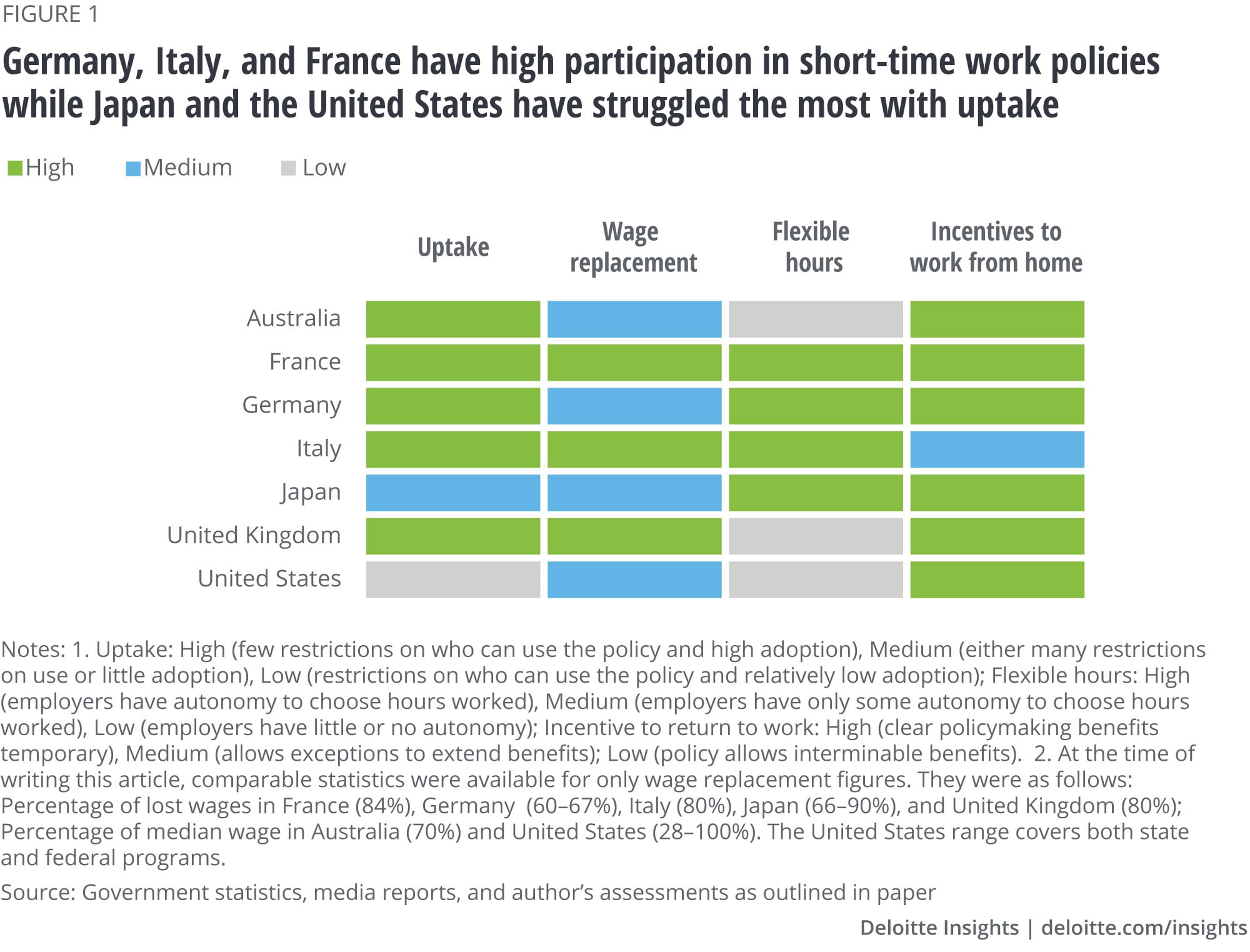
The long and short of short-time work amid COVID-19 Short-time work programs could help combat the current economic crisis—with some caveats
9 minute read
12 June 2020
High uptake and generous wage replacement coupled with higher flexibility and incentives can help short-time work policies hasten recovery—but only once COVID-19 health risks subside.
The world is experiencing the worst economic downturn since at least the Great Depression (1929–late 1930s), with the IMF expecting cumulative output losses amounting to US$9 trillion globally.1 This figure could rise considerably should the COVID-19 pandemic worsen. As the world went into lockdown to prevent the spread of COVID-19, economic policymakers across the globe reacted with unprecedented amounts of stimulus.2 They are putting loans in forbearance, providing tax relief, sending cash to residents, expanding automatic stabilizers such as unemployment insurance, and injecting liquidity into the financial system.
Learn More
Learn more about connecting for a resilient world
Explore the Economics collection
Learn about Deloitte’s services
Go straight to smart. Get the Deloitte Insights app.
One policy that has gained considerable popularity among governments and policymakers in the wake of the pandemic is short-time work,3 sometimes called a work-sharing program. The details of short-time work schemes vary by country, but they generally aim to preserve the employer-employee relationship during temporary output disruptions by allowing employers to reduce worker hours even as the government subsidizes workers’ lost wages. This enables businesses to preserve institutional knowledge and avoid the lengthy and costly process of hiring and training new workers that can restrain productivity when the economy is restarting. These short-time work programs hold the promise of helping combat the current economic crisis. However, they are designed to be temporary measures and become less effective in a worst-case scenario where the downturn lasts years and creates a huge number of bankruptcies among companies.
Although nearly every large economy has some version of a short-time work policy, not every such policy will be successful in hastening a recovery when COVID-19 health risks eventually subside.
Schemes that are widely used, provide generous wage replacement, and encourage a quick and flexible return to work are the ones that will work best.
Policy there for the taking, but what’s the uptake?
For any policy to be effective, businesses and workers first need to take it up, which requires the policy to be made widely available. It should also be clear enough for both parties to have confidence that the benefits of using the scheme outweigh any potential costs. For example, the cost of laying off workers should be higher than the cost of keeping them under the scheme. In addition, companies should consider that they need to remain in business for the duration of the temporary disruption, which requires additional assistance for other fixed costs.
Countries that had preexisting short-time work schemes, such as Germany, Italy, and France, have been better positioned to get higher participation in the policies (figure 1).4 Businesses and workers were already familiar with how these policies worked; the infrastructure for getting assistance was already established; and these countries’ governments made it costly to lay off workers. Italy even banned laying off workers altogether.5 Although the United Kingdom6 and Australia7 are relatively new adopters of short-time policies, the number of workers participating in such schemes is relatively high, with about 7.5 million workers in the United Kingdom8 and more than 6 million in Australia (numbers as of mid-May) receiving the benefit.9
The two countries that have struggled the most with uptake of their short-time work schemes are Japan and the United States.
During the global financial crisis of 2007–08, Japan’s short-time scheme covered the largest share of workers among industrialized countries.10 However, during the current crisis, the scheme has been plagued with delays and red tape, making it difficult for companies and workers alike to adopt the policy given the speed and magnitude of the current downturn.11

Half of US states already had short-time work policies in place when the current crisis hit, but their eligibility requirements are mostly ill-equipped to handle the severity of this downturn. For example, states such as New York don’t allow companies to participate in the policy if hour and wage reductions exceed 60%,12 which is likely too restrictive for many businesses that were forced to close down entirely. Similarly, the United States has implemented the Payroll Protection Program at the federal level to provide forgivable loans to small businesses, which, in turn, use a large portion of the funds to maintain payrolls. Unfortunately, the policy initially ran out of money, resulted in confusion regarding eligibility and other rules, and excluded larger businesses. Even with the new federal program in place, the United States relies heavily on its unemployment insurance scheme, which severs the link between employer and employee.13 However, both Japan and the United States took steps in April to fix some of these initial problems so the uptake of their policies could eventually improve.
Generous wage replacement schemes can help arrest downturn
The first order of business for a short-time work scheme is to diminish the fall in aggregate demand by providing funds to workers who would otherwise be out of a job. In theory, this is similar to the effect of regular unemployment benefits. However, maintaining the attachment to an employer could give workers additional confidence about future earnings and therefore lead to higher spending relative to their unemployed peers.
Countries with high uptake of the scheme and generous wage replacement rates are best positioned to prevent a more severe economic downturn.
Italy14 and France15 offer relatively generous replacement rates for lost wages, roughly 80% each. Germany is less generous, replacing between 60% and 67% of lost wages. Under more normal circumstances, a less generous replacement rate may encourage a faster return to work; however, under the current circumstances, health risks should be the determining factor for the timing and magnitude of work resumption.
In the United Kingdom16 and Australia, replacement rates have been relatively generous as well, though Australia has the benefit of a flat dollar amount, which makes the replacement rate for higher-wage workers less generous. However, in both countries, these schemes are fairly new, and policymakers are already considering cutting the replacement rate as the crisis continues and the costs pile higher.17
Conversely, Japan is increasing workers’ wage subsidies. Japan initially created incentives that caused the replacement rate to hover around 60%, but more recently has taken steps to increase subsidies closer to 100% for workers at small enterprises.18 In the United States, the state programs offer very low rates of replacement, while the federal program has the potential to offer much higher rates. Unfortunately, persistently low uptake and limited coverage at the federal level will severely impede the country’s ability to support aggregate demand through these schemes.
Hastening recovery: Flexibility is the key
The most important features of any short-time work scheme are flexibility and incentives to return to work quickly. Flexibility is critically important now, given that the ability to return to work will depend on health risks, which may ebb and flow, requiring employers to adjust the number of worker hours accordingly. Short-time work schemes in Germany, Italy, France, and Japan empower businesses with the discretion to navigate those ebbs and flows.19 The scheme in the United Kingdom was originally a furlough program, which required workers to be away from work entirely to qualify for its benefits, but policymakers have acknowledged the need to offer greater flexibility as businesses start to reopen.20
In Australia and the United States, the schemes are operationally different from their counterparts in most of Europe and Japan, which can make flexible hours difficult. In Australia, companies are expected to anticipate how long they will require the benefit while applying for it.21 However, policymakers are considering making modifications to introduce more flexibility into the scheme.22 In the United States, the federal benefit is a forgivable loan, which requires businesses to anticipate the funds they will require to cover payroll in the future.23 Given the limited availability of funding in the United States, companies may not have the option to reapply for funds should revenue shortfalls extend longer than initially expected. Without additional modifications, Australia and the United States will find it more difficult to manage the tricky balance of returning to work amid changing health risks.
Providing incentives to return to work as quickly as possible has historically hastened the subsequent recovery. Otherwise short-time work schemes risk allowing low-performing businesses to hoard labor and stifle recovery. However, given the current circumstances, companies should be encouraged to hold down production until it is safe to allow employees to return to work. Only when health risks subside will incentives to ramp up production become important.
Germany’s program, for instance, provides ample incentives as it requires businesses to pay into the scheme; charges more from those companies that have used it previously; and has them contribute to payroll taxes for hours not worked. Countries with previously established short-time work schemes generally have some form of cost-sharing with businesses that participate. However, during the last recession, Italy softened some of the skin-in-the-game requirements in its programs, which may have allowed unproductive firms to hoard labor and stifle the strength of the last recovery.24
Countries such as Australia, the United Kingdom, and the United States, which have newer short-time work schemes, initially had either time or dollar limits on their programs. Such limits lack flexibility in their current form, but they certainly discourage labor hoarding. The problem here is their potential to cause companies to go bankrupt if government assistance is removed too quickly, defeating the entire purpose of preserving the employer-employee relationship. Australia25 and the United Kingdom26 are exploring ideas on how to get this balance right, though the United States seems less apt to adopt a more flexible approach.27
Short-time work schemes are just one option in a policymaker’s toolkit. However, they have the potential to provide considerable support to economies both as they fall into recession and as they begin to recover. Widespread adoption, generous benefits, flexibility, and incentives to return to work are the hallmarks of the short-time work schemes that will perform the best in the current economic crisis.
© 2021. See Terms of Use for more information.
More on COVID-19
-
US policy response to COVID-19 aims to set the stage for recovery Article5 years ago
-
COVID-19 potential implications for the banking and capital markets sector Article5 years ago
-
Economic impact of epidemics and pandemics in Asia since 2000 Article4 years ago
-
Small positive signs in the consumers’ dual-front crisis Article4 years ago
-
The Deloitte US economic vulnerability index Article5 years ago
-
COVID-19 and the investment management industry Article5 years ago












